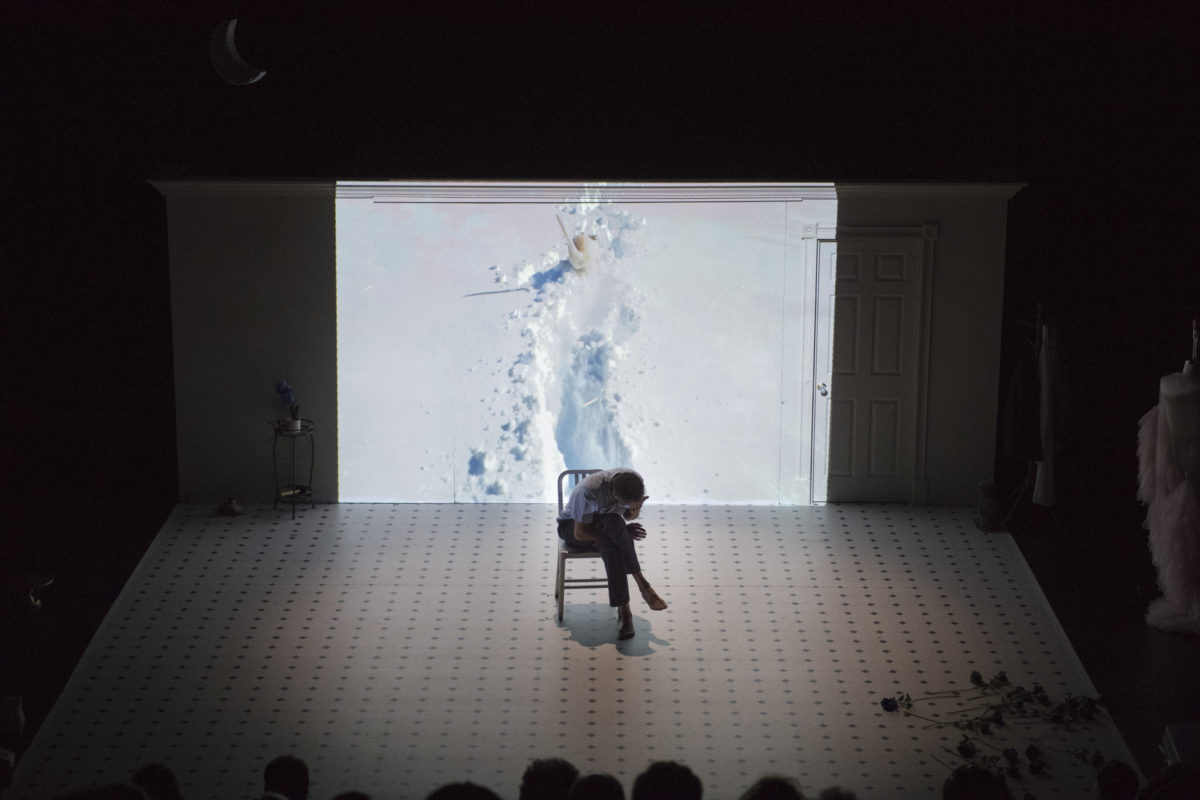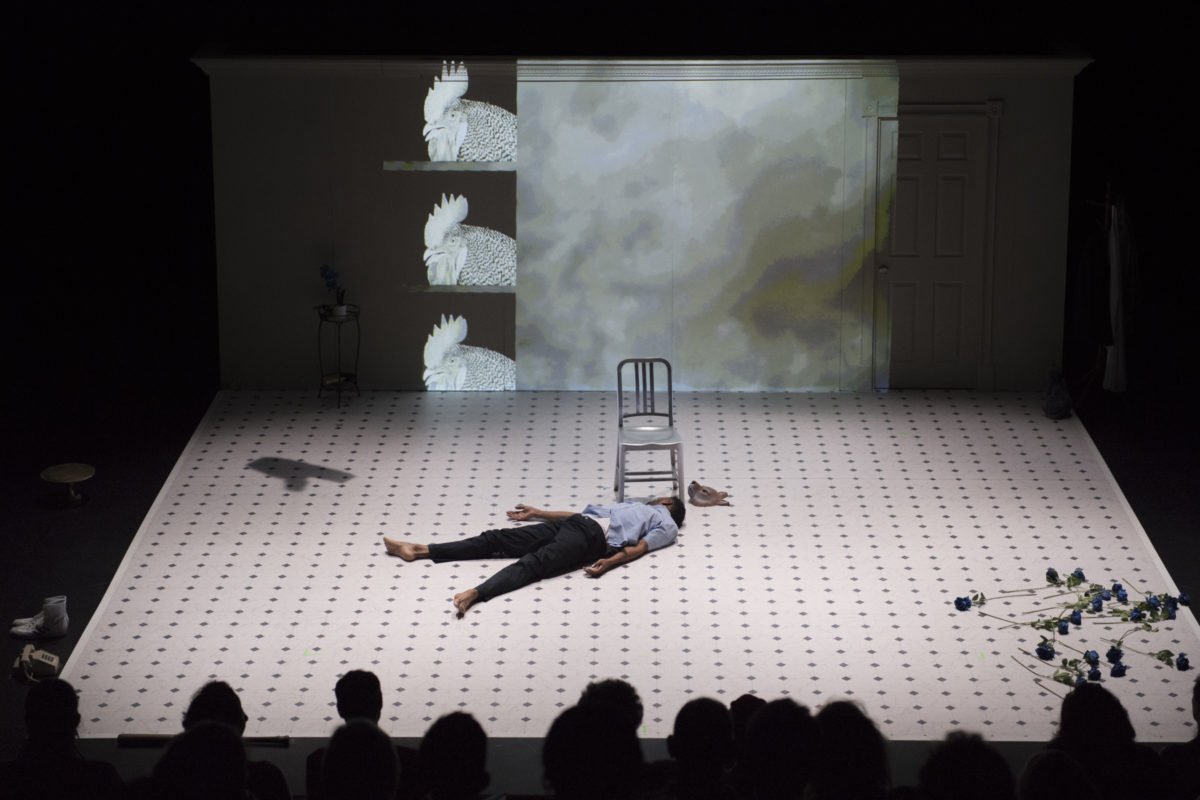
An MIT residency unlocks the dreamlike world of dance-theater piece The History of Empires
I’ve thought about it before, living in the country…it seems to me, if you’re out there alone, maybe with a farm and fields and trees and the night sky, the stars, you start to think pretty quickly how you’re all alone… I’ve always felt a lot safer living in the city where you can’t see the stars at night.
When choreographer and director Dan Safer first read these words by playwright Charles Mee, he took them personally. As artistic director since 2000 of New York–based performance company Witness Relocation, Safer’s own identity had been rooted in city life for many years. But not long after he joined MIT Theater Arts as a Lecturer in 2018, he’d found himself splitting his time between suburban Massachusetts and rural upstate New York. The Covid-19 pandemic further distanced him from the urban existence that once defined him. “My whole life was a brand-new reality—yet I was still me,” he recalls.
Excerpts from several of Mee’s works, including those lines about the country, became the backbone of The History of Empires, a dreamlike dance-theater piece Safer developed in part at MIT. The title refers to the rise and fall of civilizations, but to Safer, the realities we construct for ourselves can be seen as fragile empires in microcosm.

Pandemic origins
The project was two-plus years in the making. In the early days of the pandemic, Safer formed a pod with two other city-to-country transplants, dancer Marcus McGregor and MIT Music and Theater Arts colleague Christian Frederickson, a violist and composer. Safer was interested in making a dance piece from The House of Cards, a dark monologue written by Mee, whose work Safer has staged several times before. Safer, McGregor, and Frederickson met weekly, using music and movement to explore the text’s vivid prompts: a letter from a friend, a tortoise roasted alive, the passing of seasons, the aftermath of an explosion. How do we anchor ourselves in a world where such beauty and horror coexists? And how do we connect with others? The play offers no answers, but for the artists, working on it together became its own act of hope and connection.
As Covid restrictions eased, the trio layered in video by filmmaker Tom Kalin and recorded voiceovers by Broadway actor Kevin Mambo and German cinema star Angela Winkler. Danced solo by McGregor, House of Cards had an in-progress showing at MIT in November 2021.
Safer received a 2022 CAST Visiting Artist Grant to bring an expanded version of the project, renamed The History of Empires, back to MIT this fall with additional collaborators: set and costume designer Deb O, lighting designer Jay Ryan, and performer Daniel Pettrow. Following McGregor’s solo, Pettrow and McGregor danced the second half of the piece, based on a second play by Mee called The Talking Heads of Stone, as a duet narrated by Pettrow. It begins with the donning of paper crowns and the line from which the piece takes its title (“we see from the histories of empires none will last forever”); escalates into violence scored with pulsing, hypnotic intensity by composer Frederickson; and ends with a picnic. The nearly complete work was shown on campus in September 2022 as part of the CAST series MIT Performing, then premiered in October at New York City’s La MaMa.

Layers of design
Safer says he and his collaborators focused their MIT residency on incorporating design elements. Access to the scene and costume shops, dedicated rehearsal space, and time for experimentation added up to what Safer considers a rare artistic luxury: “the ability to interact with the design as you would interact with a performer.”
At MIT, the creative team discovered a key to the visual world of the play: leaving a jumble of props visible on the periphery of an otherwise spartan set. As particular objects—a baseball bat, an almanac, a candelabra—are taken up by the performers or referenced in the text, it’s as though they emerge from a mental attic cluttered with memories. If not for the residency, “we never would’ve learned that the placement of these objects off to the side is as much a part of the show as the choreography is,” Safer says.
During the residency Safer finally got to see the prototype of a figure he had envisioned opening the show: a grotesque monster that would shuffle and stumble across the stage, unable to answer a ringing telephone. By opening night at La MaMa, he and O had fully developed the costume into what Dance Enthusiast’s reviewer described as “a creature completely covered in plastic trash, wrapped in a king-size garbage bag….[a] misshapen mass.”
As for McGregor—a classically trained dancer returning to the stage for the first time in 15 years—the design process at MIT affected his performance more than he expected. In one scene, while Winkler’s heavily accented voice murmurs a list of harsh rules (“you may tie your shoes not with laces but with bits of wire…”), McGregor dances within a tightly confined space. At MIT, Safer and Ryan decided to delineate the space with a rectangular beam of light. During rehearsal, “they kept making the box smaller,” says McGregor. The graceful leaps and long, balletic lines he favors—a contrast to Safer’s edgy, modern style—became impossible and he was forced to find new ways to move his body.
“I was like, guys, can you give me a little bit of play?” McGregor remembers with a laugh. “In my head I needed the box to be bigger so I could move. But what they kept saying is the smaller it got, the more interesting movements I got.”

Personal interpretations
The productions seen by Cambridge and New York audiences were substantially the same, but small changes have had a ripple effect. In the La MaMa version, some of the movements McGregor created at MIT within his box of light were echoed in other scenes to strengthen continuity for his character. Refinements like this are deeply satisfying to Safer, who compares the campus residency to a Broadway show having out-of-town tryouts. “The ability to do a finished version, and then do a round-two finished version, I’ve never had that before,” he says.
While The History of Empires has no explicit narrative arc, Safer sees a thematic one: from the paralyzing isolation of the trash monster through the internal struggle of the solo and the magnetic push-and-pull of the duet, “finally landing in a place where maybe you’re okay being part of society,” as he puts it. During an audience talkback at MIT, however, he was gratified to hear a wide range of interpretations. One person picked up on a motif of endings and beginnings, a sense of “history repeating itself”; another responded to the piece’s depiction of “how quickly we can forget something that just happened”; yet another suggested the duet might represent a conflict between mind and body.
The post-show feedback “allowed me to get a sense of how the piece was reaching people,” he says. “I’m really happy for a piece to have lots of meanings, depending on who’s watching it. The fact that there were multiple reactions that all felt very accurate meant it was working—that people could really personalize the experience.”
Written by Nicole Estvanik Taylor, Arts at MIT
Editorial direction by Leah Talatinian, Arts at MIT
Images by Sham Sthankiya
